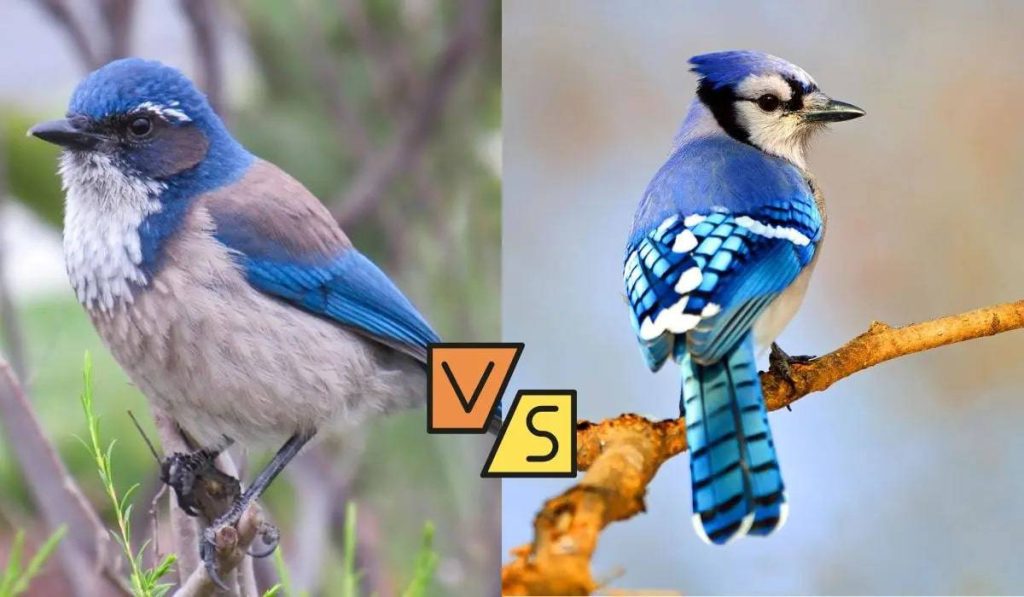Blue-colored birds are pretty confusing. Blue is such an elegant color for birds, but the number of birds with this hue can confuse the most experienced birder about which bird is which.
When you narrow this to Jay, you get even more confused. The blue jay from the Cyanocitta genus is the most popular jay, with its crest and black eye markings.
They closely resemble scrub jays and even live in the same regions as them! Do you want to know how to tell these wonderful songbirds apart?
Keep reading to learn the difference between scrub jay & blue jay!
Scrub Jay vs Blue Jay
You can find about eight types of jays found in North America. This means there are more than eight types of jays in the world. Imagine how tough it will be to tell each one apart!
The eight types of jays (family: Corvidae) found in North America are in the table below.
| Cyanocitta | Aphelocoma |
| Blue jay | Unicolored jay |
| Mexican jay | |
| Transvolcanic jay | |
| Island scrub jay | |
| California scrub jay | |
| Woodhouse’s scrub jay | |
| Florida scrub jay |
Now, what is the difference between scrub jay & blue jay?
Size and Weight

Four of the eight jays found in the US are scrub jays: Florida scrub jay (Aphelocoma coerulescens), island scrub jay (Aphelocoma insularis), Woodhouse’s scrub jay (Aphelocoma woodhouseii) and California scrub jay (Aphelocoma californica).
One reason that scrub and blue jays are easily confused with each other is that they are about the same size and weight. They both max out at 10 to 12 inches (25 to 30 cm) with a wingspan of 13 to 17 inches (34 to 43 cm) and weigh between 70 to 110 grams.
This factor is rarely considered when differentiating between the two jays. They, however, do not consume the same amount of food.
Blue jays have a larger appetite and can eat more than half their body weight to weigh a lot more in certain periods, while scrub jays eat more conservatively.
Color
While both birds are predominantly blue, there are distinctive features in their plumage which can help in their identification.
Blue jays have black markings around their eyes and necks – called a necklace – while also sporting white (male) and gray/ashy (female) underbellies. Blue jays also have different shades of blue in their plumage.
The scrub jay, meanwhile, has a white throat and a blue necklace with no eye markings. The shade of the scrub jay’s blue is also different from the shade of the blue jay. They also have one shade of blue all through their body.
The scrub jay’s underparts are grayish-brown.
Scrub jays’ colors also vary depending on the type of scrub jay you are monitoring. For instance, the Florida scrub jay has a whitish forehead, which is a notable feature that sets it apart from other jays.
Behavior and Diet
Both jays eat seeds, fruits, grains, insects, and the young eggs of other animals. Scrub jays eat small rodents, too.
Scrub jays are hoarders. They store food for future use, which makes them conservative eaters. Acorns are their favorite. Outside their similar diets, scrub jays are calmer birds.
Blue jays are aggressive and loud and like to hang out in groups even though they are monogamous when it comes to mating. Scrub jays are also monogamous when it comes to mating and are typically less noisy and less aggressive.
Both the females of scrub jays and blue jays are primarily responsible for nest siting and building.
The most significant difference is in their social behavior – blue jays tend to form larger groups, while scrub jays are more conservative, probably because they don’t want to share their food!
Adaptations to Environment
The role that both birds play in the environment cannot be overlooked. Oak trees are some of the most ecologically pleasing and useful trees to have around. Both birds enjoy acorns and this causes them to spread them around often.
They’re natural oak tree planters, making it even more important that bird watchers take care of them.
The seven different types of scrub jays have adapted to specific environments, making them an endangered species. For example, the California and Florida scrub jays are local to these two regions.
The California scrub jays can be found elsewhere sometimes, but the Florida scrub jay with its unique white forehead is only found in Florida.
Both species are very clever and can adapt to the presence of humans and their settlements in their natural habitats easily.
Symbolism
Many birders have attributed spiritual symbolism to both blue jays and scrub jays.
Jays are a curious bird species, and blue jays in particular are very intelligent. The blue jay is always ready to learn, and assimilate new ideas and concepts, and is a very intelligent bird.
The belief is that blue jays help people tap into all these parts of themselves, especially if they are taken care of quite often. The scrub jay’s ability to save or store food for later suggests that they are confident in gathering and multiplying resources.
Observing scrub jay behavior can teach us how to find, multiply, and sustain resources by imbibing a saving culture.
In general, birds from the Corvidae family are great problem solvers. It is worth noting how crows, magpies, scrub jays, and blue jays solve problems.
Final Thoughts
I hope now you will be able to differentiate between these two types of beautiful birds.
Try to set out feeders and plant enough scrubs and bushes that can help our bird buddies find food and a safe place to live.
You can also plant trees and bushes that make berries and nuts, keep your pet cats inside so they won’t chase birds, and put up a bird feeder with seeds they like.

